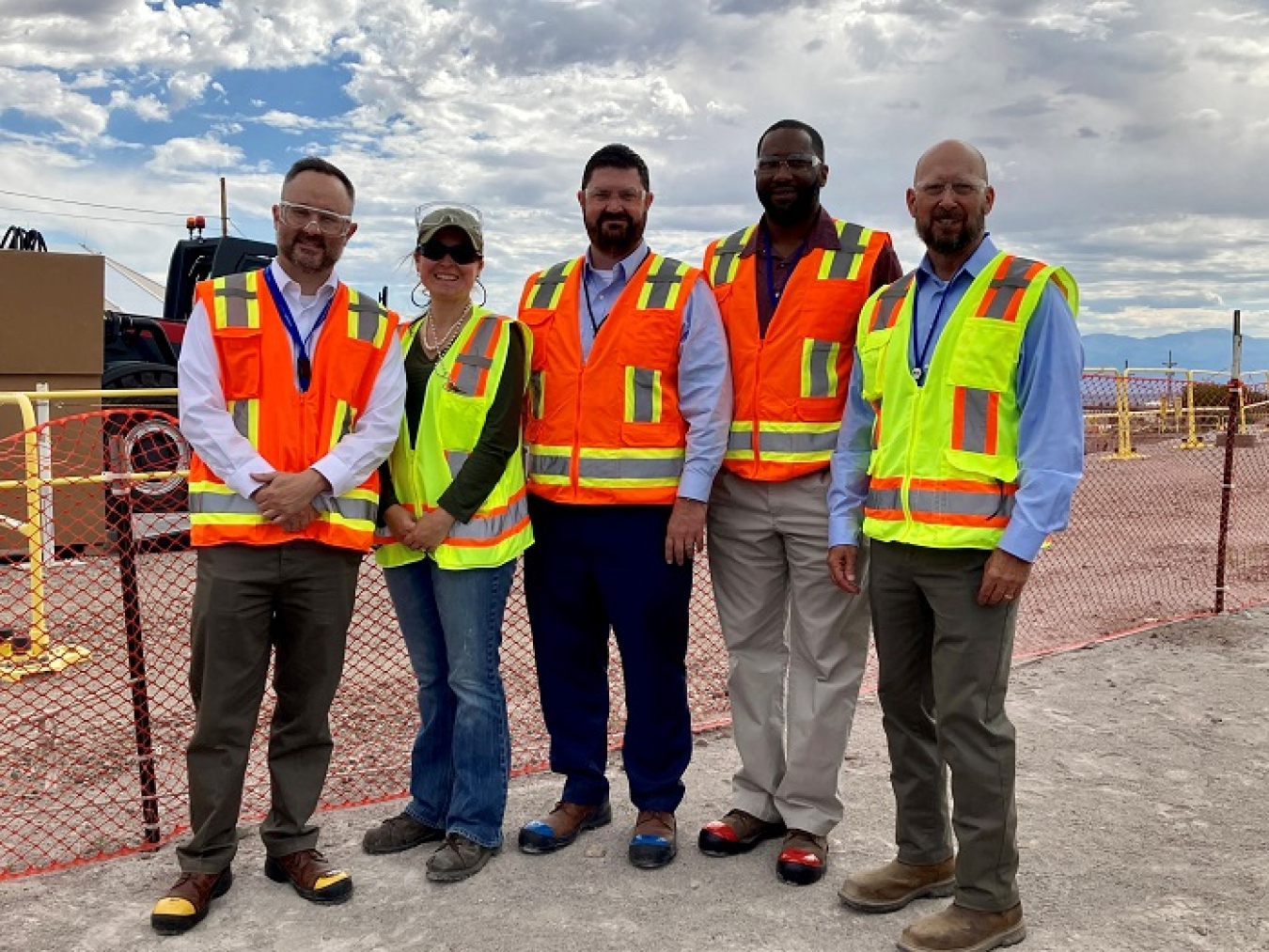Efforts to address legacy transuranic waste recently took an important step forward as the EM Los Alamos Field Office (EM-LA) and cleanup contractor Newport News Nuclear BWXT Los Alamos (N3B) have begun size reduction activities.
Office of Environmental Management
July 18, 2023
During a recent visit to the EM Los Alamos site, EM Principal Deputy Assistant Secretary Jeff Avery observed the excavation pit for corrugated metal pipe retrievals at Technical Area 54, Area G. From left: John Howard, EM deputy chief of staff; Ellie Gilbertson, deputy manager, EM Los Alamos Field Office; Avery; Aaron White, director, EM Office of Regulatory Compliance; and Brad Smith, president and general manager, Newport News Nuclear BWXT Los Alamos.
LOS ALAMOS, N.M. – Efforts to address legacy transuranic waste recently took an important step forward as the EM Los Alamos Field Office (EM-LA) and cleanup contractor Newport News Nuclear BWXT Los Alamos (N3B) have begun size reduction activities to prepare a portion of waste for permanent disposal.
EM-LA and N3B are preparing corrugated metal pipes containing transuranic waste at the Los Alamos National Laboratory (LANL) for shipment and disposal at EM’s Waste Isolation Pilot Plant (WIPP) in New Mexico. Crews recently began cutting the first retrieved pipes using hydraulic shears so that the pieces can be loaded into containers known as standard waste boxes for characterization, shipment and ultimate disposal.
“This is a significant milestone for N3B, and will help us continue to drive down legacy waste inventories at LANL and to aid the DOE Office of Environmental Management in its meeting commitments to New Mexico,” N3B President and General Manager Brad Smith said.
A significant amount of work and preparation went into ensuring N3B can perform this activity safely, Smith said.
“We’re grateful for the assistance of EM headquarters and EM-LA,” he said.
The Newport News Nuclear BWXT Los Alamos Waste Retrieval Operations crew at Technical Area 54 at Los Alamos National Laboratory guide a cut section of corrugated metal pipe filled with cemented transuranic waste into a standard waste box. Each pipe is loaded onto a pipe-roller conveyor belt before being cut into sections with a hydraulic shear, which is encased in a structure designed to prevent release of contamination to the outside environment.
The waste comes from a former LANL radioactive liquid waste treatment facility that operated during the Cold War era at Technical Area 21 (TA-21). In total, 158 pipes containing cemented waste were transported and buried at TA-54, Area G in 1986 for future retrieval.
Each pipe measures approximately 20 feet long, and weighs between 10,000 and 14,000 pounds. Given their size, the pipes must be reduced in size to be cut into five pieces, each of which is loaded into a standard waste box. N3B is working to complete the retrieval and processing of the pipes by next spring.
EM-LA and N3B conducted significant safety preparations prior to launching size reduction activities. Workers practiced processes and procedures using mock pipes before beginning cutting the actual ones.
The size reduction work takes place in Dome 375. The crew brings the pipes in one by one with a flatbed trailer onto a loading dock using a conveyer roller system. The pipe is attached to a winch, which then pulls it into position to be cut four times, resulting in five pieces approximately 4 feet long and up to 2,900 pounds.
According to N3B Waste Operator Robert Hansel, the shearing work is performed by a team of four people that includes an operator for the blade, the hoist, and the winch, and another lead person who is the reader performer. The reader performer controls the pace, sets the tone for the work and establishes a three-way communication approach that is central to reducing errors — reading the step, repeating the step and then confirming the step.
Previously, a diamond saw was envisioned to be used to perform the size reduction activities for the pipes. EM-LA and N3B shifted to the use of a hydraulic shear to improve safety and reduce potential worker exposure to dust. Prime Marine Services, Inc., an offshore decommissioning company in Broussard, Louisiana, created the initial design for the shear and N3B workers adapted it for use with the pipes. The shear operates similar to a cigar cutter to cut the pipes into pieces.
The pipes represent one of a variety of legacy waste streams at LANL that EM-LA and N3B are working collaboratively to address for disposal. To date, EM-LA and N3B have made over 152 shipments of transuranic waste to WIPP and shipped over 55,000 55-gallon drum equivalents of low-level and mixed low-level waste off-site.
To receive the latest news and updates about the Office of Environmental Management, submit your e-mail address.

